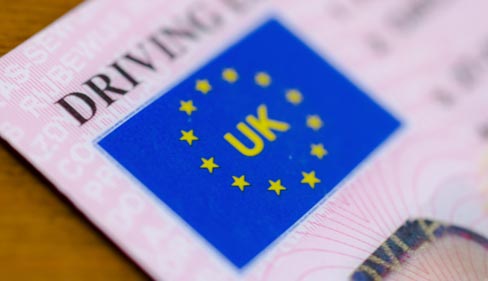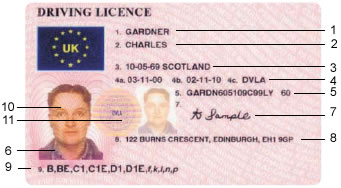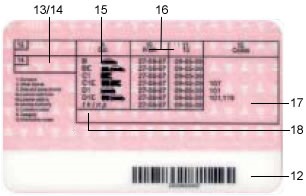
What is on your driving licence?


The date shown in 4a is the date the photocard was issued. 4b shows the date the photocard must be renewed.
The authority that issued the licence is shown in 4c.
In Great Britain that is the DVLA.
A = This is the first five letters of your surname. If your surname has fewer than five letters, the remaining spaces will be made up using the number 9 (for example, MAN99)
B = The first and last numbers are the year of your birth. The second and third numbers are the month of your birth. (If you are female, '5' is added to the second number and the total used as the second digit. So if you are a woman born in October the second and third numbers would be 60.) The fourth and fifth digits are the day of the month you were born on.
C = This is the first two initials of your first names. If you have only one inital, the second character will be a '9'.
D = Computer check digits, randomly produced as a security measure.
E = This is the licence issue number, which will increase by one with every licence issued. This number should correspond with the number on the upper right of the paper part of the licence.
Provisional entitlements are listed on the paper part of the driving licence.
These are the licence categories and what they mean.
If you hold a B, C1 or C licence, you are eligible to tow a trailer without the need for the extra +E entitlement, however there are restrictions.
Category B can pull a trailer with a MAM of 750kg and a total of 4250kg combined weight (vehicle + trailer).
Category C1 can pull a trailer with a MAM of 750kg, and a total weight of 8250kg.
Category C can pull a trailer with a MAM of 750kg.
In each case, if the MAM of the trailer exceeds 750kg, then an additional +E test will be required.
Drivers who passed their Category B test before 1 January 1997 were granted the additional C1 and C1+E entitlement automatically when they were 18 years old. These drivers, with the C1+E entitlement, are restricted to vehicles with a MAM not exceeding 8250kg. New drivers (after January 1997) are required to pass the C1 test if they wish to add this entitlement.
Knowing your licence codes
02
10
15
20
25
30
35
40
42
43
44
44(1)
44(2)
44(3)
44(4)
44(5)
44(6)
44(7)
44(8)
45
70
71
78
79
101
102
103
105
106
107
108
110
111
113
114
115
118
119
120
121
122
125
Hearing / communication aid
Modified transmission
Modified clutch
Modified braking system
Modified accelerator system
Combined braking and accelerator systems
Modified control layouts
Modified steering
Modified rear view mirror(s)
Modified driving seats
Modifications to motorbikes
Single operated brake
(adjusted) hand operated brake (front wheel)
(adjusted) foot operated brake (back wheel)
(adjusted) accelerator handle
(adjusted) manual transmission and manual clutch
(adjusted) rear view mirror(s)
(adjusted) commands (direction indicators, brake lights)
Seat height (allowing two feet on road at same time)
Motorbikes only with sidecar
Exchange of licence
Duplicate of licence
Restricted to vehicles with auto transmission
Restricted to vehicles in conformity with licence details
Not for hire or reward (not to make profit)
Drawbar trailers only
Subject to certificate of competence
Vehicle not more than 5.5 metres long
Restricted to vehicles with auto transmission
Vehicle not more than 8250 kilograms
Subject to minimum age requirements
Limited to tranpsorting persons with restricted mobility
Limited to 16 passenger seats
Limited to 16 passenger seats except for automatics
With any special controls required for safe driving
Organ donor
Start date is for earliest entitlement
Weight limit for vehicle does not apply
Complies with health standard for D1
Restricted to conditions specified by Secretary of State
Valid on completion; basic moped training course
Tricycles only